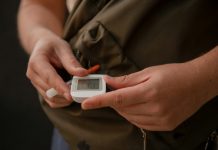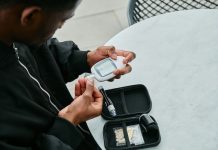
Some people with diabetes need to eat at about the same time each day. Others can be more flexible with the timing of their meals.
Depending on your diabetes medicines or type of insulin, you may need to eat the same amount of carbohydrates at the same time each day. If you take “mealtime” insulin, your eating schedule can be more flexible.
If you use certain diabetes medicines or insulin and you skip or delay a meal, your blood glucose level can drop too low. Ask your health care team when you should eat and whether you should eat before and after physical activity.
How much can I eat if I have diabetes?
Eating the right amount of food will also help you manage your blood glucose level and your weight. Your health care team can help you figure out how much food and how many calories you should eat each day.
Weight-loss planning
If you are overweight or have obesity, work with your health care team to create a weight-loss plan.
The Body Weight Planner can help you tailor your calorie and physical activity plans to reach and maintain your goal weight.
To lose weight, you need to eat fewer calories and replace less healthy foods with foods lower in calories, fat, and sugar.
If you have diabetes, are overweight or obese, and are planning to have a baby, you should try to lose any excess weight before you become pregnant. Learn more about planning for pregnancy if you have diabetes.
Meal plan methods
Two common ways to help you plan how much to eat if you have diabetes are the plate method and carbohydrate counting, also called carb counting. Check with your health care team about the method that’s best for you.
Plate method
The plate method helps you control your portion sizes. You don’t need to count calories. The plate method shows the amount of each food group you should eat. This method works best for lunch and dinner.
Use a 9-inch plate. Put nonstarchy vegetables on half of the plate; a meat or other protein on one-fourth of the plate; and a grain or other starch on the last one-fourth. Starches include starchy vegetables such as corn and peas.
You also may eat a small bowl of fruit or a piece of fruit, and drink a small glass of milk as included in your meal plan.
Portion sizes
You can use everyday objects or your hand to judge the size of a portion.
1 serving of meat or poultry is the palm of your hand or a deck of cards
1 3-ounce serving of fish is a checkbook
1 serving of cheese is six dice
1/2 cup of cooked rice or pasta is a rounded handful or a tennis ball
1 serving of a pancake or waffle is a DVD
2 tablespoons of peanut butter is a ping-pong ball
Carbohydrate counting
Carbohydrate counting involves keeping track of the amount of carbohydrates you eat and drink each day. Because carbohydrates turn into glucose in your body, they affect your blood glucose level more than other foods do.
Carb counting can help you manage your blood glucose level. If you take insulin, counting carbohydrates can help you know how much insulin to take.
Carbohydrate counting is a meal planning tool for people with diabetes who take insulin, but not all people with diabetes need to count carbohydrates.
Your health care team can help you create a personal eating plan that will best meet your needs.
The amount of carbohydrates in foods is measured in grams. To count carbohydrate grams in what you eat, you’ll need to
learn which foods have carbohydrates
read the Nutrition Facts food label, or learn to estimate the number of grams of carbohydrate in the foods you eat
add the grams of carbohydrate from each food you eat to get your total for each meal and for the day
Most carbohydrates come from starches, fruits, milk, and sweets. Try to limit carbohydrates with added sugars or those with refined grains, such as white bread and white rice.
Instead, eat carbohydrates from fruit, vegetables, whole grains, beans, and low-fat or nonfat milk.
Choose healthy carbohydrates, such as fruit, vegetables, whole grains, beans, and low-fat milk, as part of your diabetes meal plan.
In addition to using the plate method and carb counting, you may want to visit a registered dietitian (RD) for medical nutrition therapy.
If you care about diabetes, please read studies about surgery that can be a ‘cure’ for type 2 diabetes, and these two food linked to higher risk of diabetes, stroke and heart disease.
For more information about diabetes, please see recent studies about a promising new way to treat type 2 diabetes, and results showing eggs for breakfast may benefit people with diabetes.



